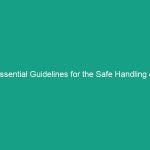Introduction
Good morning team! Today, we are going to discuss an important topic: Essential Ergonomic Lifting Aids: Using Devices to Reduce Strain Effectively. This talk is crucial for our Workplace Safety and your personal health. Lifting heavy objects can lead to strain and injury if not done properly, and that’s why utilizing ergonomic lifting aids is essential. By the end of this session, you will understand how these devices can make lifting safer and more efficient, ultimately reducing the risk of injury.
Understanding Essential Ergonomic Lifting Aids
So, what are ergonomic lifting aids? These are tools and devices designed to help workers lift, move, and carry heavy loads with minimal physical strain. They are critical in reducing the risk of musculoskeletal disorders (MSDs), which can lead to long-term health issues for employees.
Many employees might believe that lifting aids are only for those in specific roles or industries. However, the truth is that every workplace can benefit from these devices, regardless of the job type. By understanding and utilizing these aids, you can enhance your productivity and maintain your health.
Key Hazards, Risks, and Safety Considerations
Ignoring the use of ergonomic lifting aids can lead to significant Hazards such as:
- Muscle Strain: Lifting heavy items without proper support can lead to muscle tears or chronic pain.
- Injuries: Back injuries are among the most common workplace injuries, often leading to long recovery times.
- Decreased Productivity: Injured employees may require time off, which can disrupt workflow and productivity.
In real-world scenarios, many employees have faced injuries due to improper lifting techniques. For instance, a warehouse worker lifting boxes without a dolly or lift may suffer from severe back pain, leading to days or even weeks off work.
Best Practices, Procedures, & Actionable Advice
Now that we understand the risks, let’s discuss Best Practices for using ergonomic lifting aids effectively:
1. Assess the Load
Before attempting to lift any object, assess its weight and dimensions. If it feels too heavy or awkward, always seek assistance or use a lifting aid.
2. Utilize Lifting Devices
Here are some essential ergonomic lifting aids you should consider:
- Dollies and Hand Trucks: These are perfect for transporting heavy items without direct lifting.
- Forklifts: For larger loads, forklifts can effectively lift and move items with minimal effort.
- Lift Tables: These allow you to raise or lower heavy items to a more manageable height, reducing strain.
- Slings and Hoists: These can help lift very heavy items securely and safely.
3. Proper Lifting Techniques
When lifting is unavoidable, use proper techniques:
- Keep your feet shoulder-width apart; this provides a stable base.
- Bend at the knees, not at the waist.
- Keep the load close to your body; this reduces strain on your back.
- Lift with your legs, not your back.
4. Regular Training
Participate in regular training sessions to refresh your knowledge about lifting techniques and the proper use of lifting aids. This will ensure that Safety remains a priority within our workplace.
Regulations, Standards, and Compliance
It’s essential to understand that there are Regulations and Standards in place to protect workers from injury. The Occupational Safety and Health Administration (OSHA) has guidelines regarding lifting practices and the use of ergonomic equipment. Compliance with these regulations is not just about avoiding fines; it’s about ensuring a safe working Environment for everyone.
By adhering to these standards, we protect ourselves and our coworkers from unnecessary injuries and create a culture of safety within our organization.
Employee Engagement & Discussion
Now, let’s open the floor for discussion. What safety challenges have you encountered related to lifting and moving heavy objects? Have any of you used ergonomic lifting aids before? What was your experience? Your insights can help us all learn and improve our safety practices.
Conclusion & Key Takeaways
In summary, the use of essential ergonomic lifting aids is crucial in reducing strain and preventing injuries in the workplace. Remember to assess your loads, utilize the right devices, and employ proper lifting techniques. Regular training and compliance with safety standards will ensure that we maintain a safe work environment. Thank you for your attention today, and I encourage you to prioritize safety every day. Together, we can create a healthier and safer workplace for everyone!


